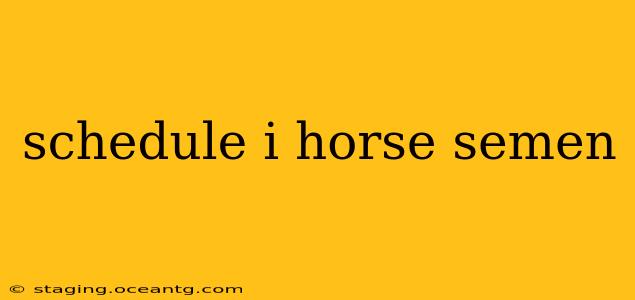The equine breeding industry is increasingly reliant on advanced technologies to enhance efficiency and improve reproductive outcomes. Artificial insemination (AI) has become a cornerstone of modern horse breeding, and the precise scheduling of semen collection and processing is critical for success. This article delves into the intricacies of scheduling AI in horse semen management, addressing key aspects from stallion health to cryopreservation techniques.
What Factors Influence the Scheduling of AI in Horse Semen Collection?
Several factors play a crucial role in determining the optimal schedule for AI semen collection:
-
Stallion's Reproductive Health: Regular veterinary checkups are essential to monitor the stallion's health and reproductive capacity. Semen quality can fluctuate based on the stallion's age, overall health, and recent activity. A thorough examination helps identify potential problems that may impact semen collection schedules.
-
Mare's Reproductive Cycle: Understanding the mare's estrous cycle is paramount. AI must be timed to coincide with ovulation, typically occurring 24-48 hours after the onset of estrus. Ultrasound monitoring and hormonal testing help pinpoint the precise time for insemination.
-
Semen Collection Techniques: The chosen method of semen collection, whether by artificial vagina (AV) or rectal probe, can influence the schedule. AV collection generally yields larger volumes of semen, potentially allowing for greater flexibility in scheduling.
-
Semen Processing and Storage: The techniques employed for semen processing, such as extension and cryopreservation, significantly impact the time available for insemination. Fresh semen has a limited lifespan, whereas frozen semen can be stored for extended periods, offering greater flexibility in scheduling AI.
-
Shipping and Transportation: If the semen is being shipped to another location, logistical considerations become crucial. Transit time, shipping regulations, and the preservation method used dictate the optimal collection and shipping schedules. Maintaining semen viability during transport is crucial for successful AI.
How is AI Technology Used in Horse Semen Management?
AI is not just about artificial insemination itself, it also plays a role in the management of the process. Data management software can track stallion and mare reproductive cycles, semen quality parameters, and insemination results. This data-driven approach allows breeders to optimize schedules, predict outcomes, and make informed decisions about breeding strategies. Additionally, advanced imaging and analysis tools can aid in evaluating semen quality, assisting in the selection of high-quality samples for AI.
What are the Key Considerations for Scheduling AI with Cryopreserved Semen?
Cryopreservation, or freezing semen, introduces additional complexities to scheduling.
-
Semen Quality Before Freezing: Only high-quality semen should be cryopreserved. Poor quality semen is more susceptible to damage during the freezing and thawing process.
-
Thawing Procedures: Correct thawing procedures are vital to maintain semen viability. Incorrect thawing can negatively affect sperm motility and fertilization rates.
-
Storage and Transportation of Frozen Semen: Proper storage conditions are crucial to maintain semen viability. The temperature must be consistently maintained throughout the storage and transportation process.
How Does the Schedule Differ for Fresh vs. Frozen Semen?
The schedules differ significantly:
-
Fresh Semen: The collection and insemination must be closely coordinated, typically within a few hours. This requires precise timing and often involves immediate transportation to the mare.
-
Frozen Semen: The collection process is less time-sensitive. The semen can be frozen and stored for extended periods, allowing for greater flexibility in breeding schedules. However, the thawing and insemination process still needs meticulous execution.
What are the Potential Challenges in Scheduling AI for Horse Semen?
Despite the advantages of AI, scheduling can present challenges:
-
Unexpected Delays: Weather conditions, transportation issues, or stallion health problems can disrupt the carefully planned schedule.
-
Inconsistent Semen Quality: The quality of semen can vary from collection to collection, requiring flexibility in scheduling.
-
Mare's Response to Hormones: The mare's response to hormonal treatments can be unpredictable, sometimes affecting the optimal time for AI.
In conclusion, successful scheduling of AI in horse semen management is a complex process requiring careful planning, meticulous execution, and a thorough understanding of both equine reproductive physiology and the intricacies of semen handling techniques. The integration of AI technology and careful monitoring of both the stallion and mare contributes significantly to optimizing reproductive success.
